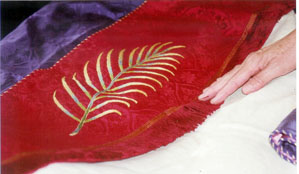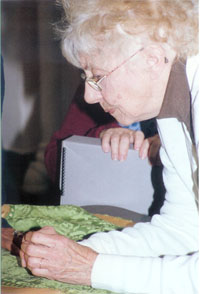 Vestments and altar hangings are more than a colorful, occasionally changing backdrop to worship. They are congregational treasurers that enhance the liturgy, says Mary Wagner, who volunteers in preserving and repairing vestments at the Convent of St. John Baptist in Mendham, N.J.
Vestments and altar hangings are more than a colorful, occasionally changing backdrop to worship. They are congregational treasurers that enhance the liturgy, says Mary Wagner, who volunteers in preserving and repairing vestments at the Convent of St. John Baptist in Mendham, N.J.
“The vestments — whatever they are, they could be simple canvas; they don’t have to be elaborate — they are the treasures of your church, and through them is another way of holding your attention when you are in the house of God,” she says. Whether burlap or brocade, they’re “invaluable as far as I’m concerned.”
Wagner works to preserve such treasures, and teach others how to do it. In February, she and fellow convent volunteer and ecclesiastical embroiderer Carol Homer will lead a workshop on vestment restoration in Mendham.
The art of vestment repair and preservation isn’t as tricky as some fear, Homer notes.
“I am convinced that in every congregation you have the talent to save and preserve these things,” she says. “Sometimes it’s a simple stitch or a matter of housecleaning — I don’t really expect to make people expert stitchers. I think that a lot of people are capable of doing it. Are they going to do an absolute expert job? Probably not. But you probably don’t need an absolute expert job.”
Wagner offers these tips for keeping a congregation’s cloth treasures safe
“Good housekeeping does a lot.” Examine vestment storage areas. Are there leaks or “creepy crawlies” such as mice or insects? Is the room excessively hot in summer or unheated in winter?
 “Look for moisture. If you have metal handles — and they’re getting rusty, that’s a bad sign.” You may want to install a dehumidifier.
“Look for moisture. If you have metal handles — and they’re getting rusty, that’s a bad sign.” You may want to install a dehumidifier.
Don’t just eyeball a full storage area. “You have to take everything out, one by one — It’s a good idea to take things out once a year and just let them breathe.”
Hang vestments on fabric-padded hangers. Wire hangers eventually cut the fabric, damaging the shoulder areas, “which can be costly to repair.” The hangers should be unwrinkled at the top, where garments will touch, and stitched on the bottom, so that the garment won’t rub against the stitching.
Store hanging vestments beneath a simple muslin or cotton cover, stitched down the front.
Line wood storage drawers with Tyvek#, a durable substance that protects vestments from dust and prevents stains from the wood.
Don’t wear jewelry such as rings while handling vestments.
To clean an old, dusty vestment, try vacuuming it. Wrap the vacuum nozzle six to eight times with old pantyhose, then secure it with an elastic band. Place a screen over the garment. Vacuum on the lowest setting, cleaning the inside of the garment first. Work in a pattern — for example, top to bottom — to be sure to get every inch. When cleaning the outside, double or triple the screen and barely touch it with the nozzle when vacuuming over stitching. “You will find a marked difference in the garment if you have the patience and the time to do this. It’s a very delicate operation. I prefer that people do it in front of me the first time.”
Catalogue your collection. Photograph vestments front and back, on a person and hanging alone. Make two copies and place each with an identical notebook listing the vestments. If you wish, add details about the history of each vestment, such as when it was dedicated. You also can include photographs of how the altar is set up for various occasions, such as Easter.
Keep one copy of the catalogue at the church, the other stored safely offsite. It will prove invaluable in case of fire.
Photos also provide a convenient way to show someone your vestments. “You don’t have to drag them through your collection.”
by Sharon Sheridan for Episcopal Life
